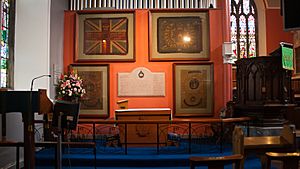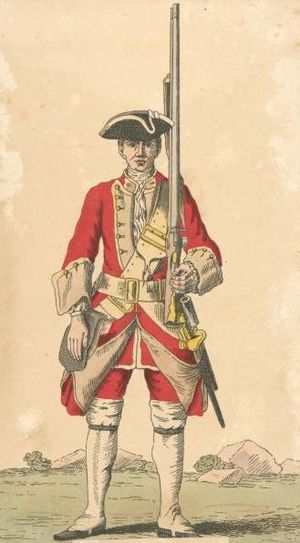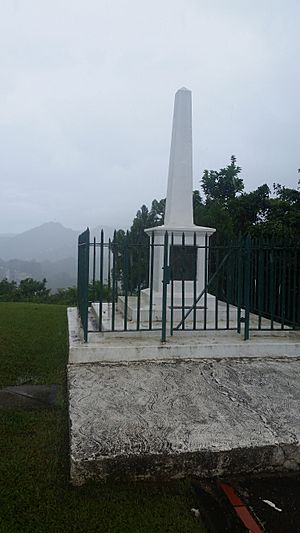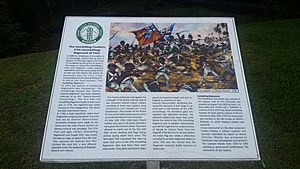27th (Inniskilling) Regiment of Foot facts for kids
Quick facts for kids 27th Inniskilling Regiment of Foot |
|
|---|---|

Badge of the 27th (Inniskilling) Regiment of Foot
|
|
| Active | 1689-1881, became Royal Inniskilling Fusiliers |
| Country | |
| Branch | |
| Type | Line Infantry |
| Size | Regiment |
| Garrison/HQ | St Lucia Barracks, Omagh |
| Nickname(s) | The Skins |
| Engagements | Battle of the Boyne (1690) Battle of Falkirk Muir (1746) Battle of Culloden (1746) Battle of Maida (1806) Siege of Badajoz (1812) Battle of Salamanca (1812) Battle of Castalla (1813) Battle of Vitoria (1813) Battle of the Pyrenees (1813) Battle of Ordal (1813) Battle of Nivelle (1813) Battle of Orthez (1814) Battle of Toulouse (1814) Battle of Waterloo (1815) |
The 27th (Inniskilling) Regiment of Foot was a famous Irish army group. It was part of the British Army and was formed way back in 1689. This group of soldiers was known for being tough and brave.
Later, in 1881, the regiment joined with another group called the 108th (Madras Infantry) Regiment of Foot. Together, they became the Royal Inniskilling Fusiliers. This change was part of a big army update called the Childers Reforms.
Contents
A Look Back: The Regiment's Story
Starting Out: Early Years
The regiment began in June 1689 in a place called Enniskillen. It was first a local group of citizen soldiers, or militia. Colonel Zachariah Tiffin led them. Their first job was to fight against King James II in a conflict known as the Williamite War in Ireland.
The soldiers did very well in their early battles. They won at the Battle of Newtownbutler in July 1689. Because of their success, they became a regular army regiment in 1690. After that, they fought in important battles like the Battle of the Boyne in July 1690. They also fought at the Battle of Aughrim and the Siege of Limerick. A part of the regiment also helped in the Siege of Namur in 1695. This was during a bigger conflict called the Nine Years' War.
In 1739, the regiment traveled to the West Indies. They returned home in December 1740. They then helped the government stop the Jacobite rising of 1745. They fought in the Battle of Falkirk and the Battle of Culloden in 1746. Around this time, people often called them Blakeney's Regiment. This was after their leader, Colonel-in-Chief Blakeney. In 1751, their name officially became the 27th (Enniskillen) Regiment of Foot.
The regiment went to Canada in 1756. There, they fought against the French. They took part in battles like the Battle of Carillon and the Battle of Ticonderoga. The next year, they helped capture Montreal in September 1760. This was part of the Seven Years' War.
After Canada, they helped invade Martinique in 1762. They also helped capture Grenada and fought in the Battle of Havana. This was during the Anglo-Spanish War. The regiment lost many soldiers in Havana. They had to go to New York to recover. In 1767, they finally returned to Ireland.
In 1775, the regiment went back to North America. They joined the American War of Independence. When France joined the American side, the regiment fought in many battles in the French West Indies. The war with France ended in 1783. But it started again ten years later with the French Revolutionary Wars. The regiment fought in the Flanders Campaign in 1793. In 1796, the 27th took Saint Lucia from the French. Their flag was even flown for a short time over the captured fort there.
Fighting in the Napoleonic Wars
The 27th Regiment played a big part in the Napoleonic Wars. They served in Egypt in 1801. There, they fought in the Battle of Alexandria against the French. After the city was captured, one part of the regiment stayed to guard it. Another part, the 1st Battalion, fought in Italy. They were at the Battle of Maida on July 4, 1806.
The 1st Battalion joined the Peninsular War in Spain in 1812. They fought in the Battle of Castalla and the Siege of Tarragona in 1813. The 2nd Battalion also arrived in Spain in December 1812. They fought bravely at Castalla on April 13, 1813. They caused heavy losses to the French army in just a few minutes. However, on September 13, 1813, the French surprised the 2nd Battalion at the Battle of Ordal. The battalion lost over 360 men in this tough fight.
The 3rd Battalion arrived in Lisbon in 1808. They became part of Arthur Wellesley, 1st Duke of Wellington's army. They fought in many important battles. These included Badajoz in 1812 and Salamanca in 1812. They also fought at Vitoria in 1813 and the Pyrenees in 1813. They then followed the French army into France. There, they fought at Nivelle, Orthez, and Toulouse. The 3rd Battalion was known for its courage. At the Battle of Sorauren (Pyrenees), they lost many men. At Toulouse, they also faced heavy casualties.

The 1st Battalion went on to fight in the famous Battle of Waterloo. This was a huge battle in 1815. At Waterloo, the French captured a key farmhouse. They then used cannons to fire at the British lines from very close. The 1st Battalion, with 698 soldiers, was in a special defensive shape called a square. Even though the French cannons caused huge losses, the battalion held its ground. They lost 478 soldiers, but they did not break. People said the unit was "lying dead in a square." At Waterloo, the soldiers wore red jackets and tall hats. Their uniform had buff-colored details.
The Victorian Era and Beyond
Between 1837 and 1847, the 27th Regiment was involved in several Xhosa Wars in South Africa. In 1840, the spelling of 'Enniskillen' changed to 'Inniskilling'. This new spelling was closer to the original Irish name. The regiment also earned the nickname The Skins. From 1854 to 1868, they served in India. They helped keep peace during the Indian Mutiny.
In the 1870s, the army made more changes. These were called the Cardwell Reforms. Single-battalion regiments were linked together. The 27th was linked with the 108th (Madras Infantry) Regiment of Foot. They shared a training base in Omagh. Then, on July 1, 1881, the Childers Reforms came into effect. The 27th Regiment officially joined with the 108th. They formed the Royal Inniskilling Fusiliers. The "Twenty-Seventh" became the 1st Battalion of this new regiment.
Battle Honors: What They Achieved
The regiment earned many special awards called Battle Honours. These show where they fought bravely. Here are some of them:
- West Indies: For their actions at St. Lucia in 1796.
- Napoleonic Wars: For fighting in Egypt, Maida, and Waterloo.
- Peninsular War: For battles like Badajoz, Salamanca, Vittoria, Pyrenees, Nivelle, Orthes, and Toulouse. They also earned "Peninsula" for the whole campaign.
- Other honors include Martinique 1762, Havannah, St. Lucia 1778, South Africa 1835, and 1846-47.
Images for kids
-
The regimental chapel in St Macartin's Cathedral, Enniskillen with the regiment's old flags







